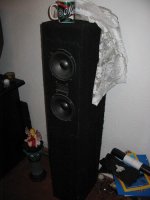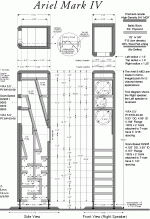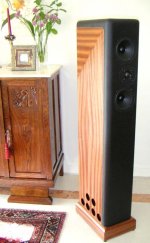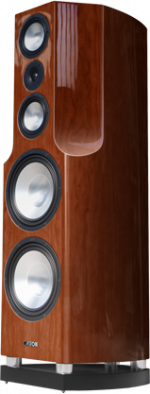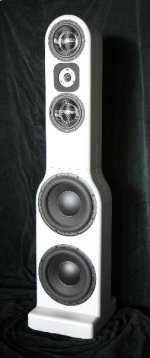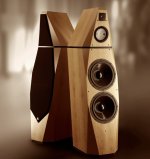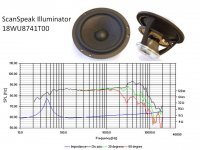I'm plotting a new pair of two-ways. I'll be using two 5" drivers and a treble (actually a Jordan JXR6 so crossing around 700 - 1000Hz).
I've read the original Joseph D"Appolito articles in Speaker Builder and see the logic behind the MTM arrangement.I note that it used to be more popular in speakers available commercially (early Meridians, for instance). Looking around now, it seems to be used less.
Do any of you have a preference for using either MTM or MMT (the two mid/bass units below the tweeter)? Is there some subsequent research which has caused it to fall out of favour?
The only thread I've found which addresses this is
http://www.diyaudio.com/forums/multi-way/2655-mtm-vs-two-way.html
I should add that the two mid/bass drivers will be run in parallel on the same baffle - I'm not intending to roll them off at different frequencies.
All input appreciated.
I've read the original Joseph D"Appolito articles in Speaker Builder and see the logic behind the MTM arrangement.I note that it used to be more popular in speakers available commercially (early Meridians, for instance). Looking around now, it seems to be used less.
Do any of you have a preference for using either MTM or MMT (the two mid/bass units below the tweeter)? Is there some subsequent research which has caused it to fall out of favour?
The only thread I've found which addresses this is
http://www.diyaudio.com/forums/multi-way/2655-mtm-vs-two-way.html
I should add that the two mid/bass drivers will be run in parallel on the same baffle - I'm not intending to roll them off at different frequencies.
All input appreciated.
seems you have dealt with some issues of the MTM principle, by your choise of drivers, enabling a low xo 'point'
MMT have its own issues as well, by using double woofers, crossed high
probably a matter of picking what kind of poison you can deal with
but since you ask, I guess you know that
height of box will be different
MTM needs to have tweeter exactly at listening height
with MMT, tweeter only needs to be slightly above
MMT have its own issues as well, by using double woofers, crossed high
probably a matter of picking what kind of poison you can deal with
but since you ask, I guess you know that
height of box will be different
MTM needs to have tweeter exactly at listening height
with MMT, tweeter only needs to be slightly above
The MMT arrangement 'fouls up' the polar response, keep the tweeter in the middle, do you calculations for the driver spacing. Radius off the baffle edge & keep it narrow.....imaging is spectacular, but keep it up high on-axis best possible to your listening position. You could further apply some absorbent material on the front of the baffle....with all this, group delay will be virtually non-existent.
Will you be able to use a subwoofer with this arrangement?
_______________________________________________________Rick.........
Will you be able to use a subwoofer with this arrangement?
_______________________________________________________Rick.........
Attachments
If you can move the handoff frequency beyond 3kHz you will surely avoid "fouling up" the most sensitive frequency region in which the ear-brain combo will sub-conciously tell you that is enough for today! Listening to music should not involve extraneous brain activity such as caused when it needs to interpret noise... yes XO's introduce signal deformations that are simply noise in the music signatures.
MTM is good way to go, and is in fact my next and final build project...coming right up!
I have tried many, and none are perfect... just pick one and become happy with the result if well planned (informed).
Louis
MTM is good way to go, and is in fact my next and final build project...coming right up!
I have tried many, and none are perfect... just pick one and become happy with the result if well planned (informed).
Louis
Is there some subsequent research which has caused it to fall out of favour?
It's a matter of opinion, but if you see the goal of an MTM as controlling lobing around the crossover to balance the tone of room reflections, then reducing those reflections using waveguides might be the current trend.
If you see the (quasi) point source as the benefit then the unity horn might respresent an advance. Naturally they are more difficult to build and so the MTM still has its place.
If you can move the handoff frequency beyond 3kHz you will surely avoid "fouling up"
Louis
ehh, what ? with double woofers MMT ?
actually, I think Focal/JaqueMahul was first with the 2.5way
and we all thought, dodgy and strange
but it tested good, so..
wonder if they were fully aware of why it worked
but we have been asked not to.., sorry
Hi,
MTM guarantees a symmetrical vertical polar response on the tweeter axis,
irrespective of how well or poorly the crossover is designed, by default.
MMT is usually 0.5 way for the MM, and has less vertical lobing due
to there only being two sources at the c/o point, MTM has three.
As stated by others MMT is physically shorter in height, can be a factor.
MTM's with fairly high c/o points can and do create a power response
that is relatively unpleasant for a flat axial response compared to a MT.
(This is basically due to line type effects around the c/o point.)
As a final note MTM is a staple of AV systems, as the centre can appear
to match the the Left and Right, but not really, and consequently " real
hifi" speakers tend to go for MT or MMT out of anti AV MTM snobbery.
Not completely unfounded IMHO technically, but FWIW there are MMT
that are pure two ways, not 2.5 ways or variations thereof, and with
a low c/o point and two 5" bass drivers its certainly doable, the two
drivers being equivalent to a 10"x5" racetrack, and 1kHz is OK for 10".
rgds, sreten.
MTM guarantees a symmetrical vertical polar response on the tweeter axis,
irrespective of how well or poorly the crossover is designed, by default.
MMT is usually 0.5 way for the MM, and has less vertical lobing due
to there only being two sources at the c/o point, MTM has three.
As stated by others MMT is physically shorter in height, can be a factor.
MTM's with fairly high c/o points can and do create a power response
that is relatively unpleasant for a flat axial response compared to a MT.
(This is basically due to line type effects around the c/o point.)
As a final note MTM is a staple of AV systems, as the centre can appear
to match the the Left and Right, but not really, and consequently " real
hifi" speakers tend to go for MT or MMT out of anti AV MTM snobbery.
Not completely unfounded IMHO technically, but FWIW there are MMT
that are pure two ways, not 2.5 ways or variations thereof, and with
a low c/o point and two 5" bass drivers its certainly doable, the two
drivers being equivalent to a 10"x5" racetrack, and 1kHz is OK for 10".
rgds, sreten.
ehh, what ? with double woofers MMT ?
I dont follow you here??
Firstly, I would go MTM and not your MMT preference .... for me, vertical box placement is pedestal dependent. My suggestion in first posting is to remind the often overlooked need to avoid "fouling" the most important portion of the frequency range when crossing over "too low" in the 300-3000 Hz region.
but we have been asked not to.., sorry
What are we alluding to here?
Maybe I need to read completed sentences to get the intent?
Louis
not sure a 2.5 way makes much sense with such low xo point
but I see one possible issue in a design like this, with low xo point
its the bigger xo components
funny, a few years back I had some ideas about a 3way, with a top section exactly like what you suggest here
two small woofers, with a small 'widerange'
and I had the exact same 'question'
but I see one possible issue in a design like this, with low xo point
its the bigger xo components
funny, a few years back I had some ideas about a 3way, with a top section exactly like what you suggest here
two small woofers, with a small 'widerange'
and I had the exact same 'question'
My suggestion in first posting is to remind the often overlooked need to avoid "fouling" the most important portion of the frequency range when crossing over "too low" in the 300-3000 Hz region.
Louis
fair enough, but its 'old school'
its an 'idea', and not a fact
from the days when they had no idea about crossovers
I would say, maybe halfway true
but its become commonly known that you cannot have high xo point with MTM designs
thats why his choice of drivers ought to work
fair enough, but its 'old school'
its an 'idea', and not a fact
from the days when they had no idea about crossovers
I would say, maybe halfway true
Oops! maybe the science of mathematics/trigonometry has changed, and nowadays audiophiles know a better way to design passive crossovers?
Would you care to explain how "new school" hearing abilities have done away with what tired the brain with "old school" audiophiles?
Regardless of opinions on the subject, an improvement is to do away with passive components by adopting active/multi-amping... what and how we hear with this approach is surprising.
Louis
Would you care to explain how "new school" hearing abilities have done away with what tired the brain with "old school" audiophiles?
Louis
sorry, no, I would not like to spoil a very good thread
already close to doing that
I suggest we forget about this, please
Last edited by a moderator:
MTM guarantees a symmetrical vertical polar response on the tweeter axis,
irrespective of how well or poorly the crossover is designed, by default.
Yes, but surely you'd agree that crossover design is more critical with an MTM.
Yes, but surely you'd agree that crossover design is more critical with an MTM.
Hi,
Yes, but surely you'd agree it can be touted as an advantage irrespective
of the real crossover issues as a superior "technical fact" for marketing.
rgds, sreten.
Things like the line array effects though not being too bad for vertical
MTM''s used left and and right being a total disaster area for the centre.
Last edited:
You may have already visited Lynn Olson's project pages plus the ensuing "builders club" pages on the subject of the Ariel (transmission line MTM) and ME2 (bass reflex version).
Consulting these pages would be beneficial for anyone contemplating an d'Appolito MTM configuration. The passive crossover design is very well described, and touches on the manner of overcoming the mid band coloration detected with the d'Appolito arangement.
Ariel Speaker Page
p.s. crossover done around 3.8kHz from the 5.5 inch mid-woofers.
Louis
Consulting these pages would be beneficial for anyone contemplating an d'Appolito MTM configuration. The passive crossover design is very well described, and touches on the manner of overcoming the mid band coloration detected with the d'Appolito arangement.
Ariel Speaker Page
p.s. crossover done around 3.8kHz from the 5.5 inch mid-woofers.
Louis
You may have already visited Lynn Olson's project pages plus the ensuing "builders club" pages on the subject of the Ariel (transmission line MTM) and ME2 (bass reflex version).
Consulting these pages would be beneficial for anyone contemplating an d'Appolito MTM configuration. The passive crossover design is very well described, and touches on the manner of overcoming the mid band coloration detected with the d'Appolito arangement.
Ariel Speaker Page
p.s. crossover done around 3.8kHz from the 5.5 inch mid-woofers.
Louis
Hi,
Not really. Both designs are a head in the sand attitude to "baffle
step compensation" and very wrong, though they can be fixed.
You may be right about some of the MTM issues he covers, but
I got bored with the Ariel thread years ago, its not accurate.
FWIW IMO L.O. talks far too much without his brain in gear. Lots
of people like it, but they don't have their brains in gear either.
rgds, sreten.
He talks a lot, as anyone familiar will know, but not concisely,
its conjectural stuff that is not the way I'd inform someone.
Last edited:
Colin,
Using a mid-tweeter and XOing low gets rid of many of the issues with an MTM. With your driver spacing, driver centre-to-centre will be in the ball-park of 1/4 wavelength, making the drivers essentially co-incident at the XO.
My example MTM also used a mid-tweeter, a bit bigger, with bigger helper woofers, ending up working REALLY well.

http://www.diyaudio.com/forums/css/176790-el166-mtm-ml-tl.html
dave
Using a mid-tweeter and XOing low gets rid of many of the issues with an MTM. With your driver spacing, driver centre-to-centre will be in the ball-park of 1/4 wavelength, making the drivers essentially co-incident at the XO.
My example MTM also used a mid-tweeter, a bit bigger, with bigger helper woofers, ending up working REALLY well.

http://www.diyaudio.com/forums/css/176790-el166-mtm-ml-tl.html
dave
I believe an MTM alignment is best used for either:
1) A two way dual transmission lines or dual MLTLs design as a modern Lynn Olson Ariel. Use 5"-5.5" M and a small diameter T . Keep MTM physical distances as short as possible. Use an odd order crossover 3rd, 5th, 7th. Quater round on all edges to reduce diffraction. Include adjustable baffle step compensation.
2) Using the MTM alignment to increase efficiency to 94-96db/watt as part of a MTM-WW speaker. I think it is worth the effort to build high'ish efficiency speakers.
Personally, I favor TMW or TMWW with a large'ish diameter M like Avalon ISIS 7" M + two 13" W. High'ish 94-96db/watt efficiency goals. A 7" M with a clever cone profile can provide good polar response and modest lobing at 1.5Khz.
1) A two way dual transmission lines or dual MLTLs design as a modern Lynn Olson Ariel. Use 5"-5.5" M and a small diameter T . Keep MTM physical distances as short as possible. Use an odd order crossover 3rd, 5th, 7th. Quater round on all edges to reduce diffraction. Include adjustable baffle step compensation.
2) Using the MTM alignment to increase efficiency to 94-96db/watt as part of a MTM-WW speaker. I think it is worth the effort to build high'ish efficiency speakers.
Personally, I favor TMW or TMWW with a large'ish diameter M like Avalon ISIS 7" M + two 13" W. High'ish 94-96db/watt efficiency goals. A 7" M with a clever cone profile can provide good polar response and modest lobing at 1.5Khz.
Attachments
- Status
- This old topic is closed. If you want to reopen this topic, contact a moderator using the "Report Post" button.
- Home
- Loudspeakers
- Multi-Way
- To MTM or not to MTM?
